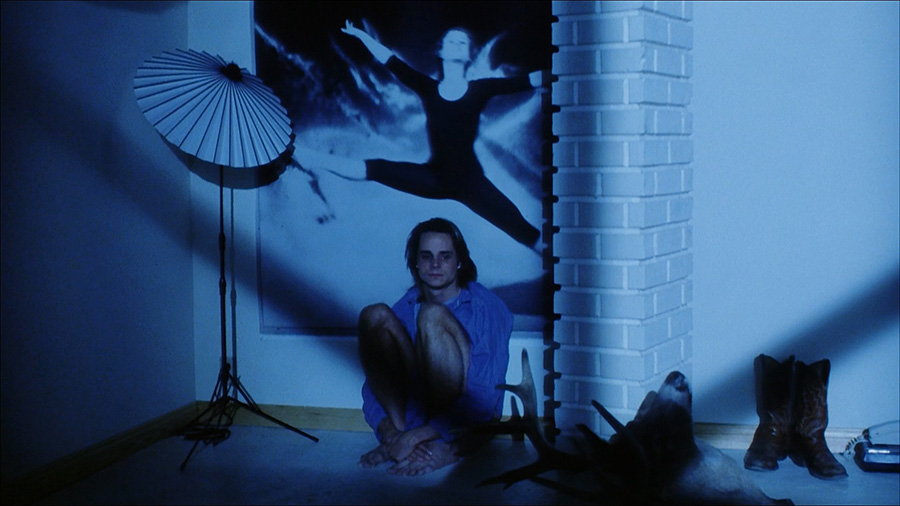DEADLY DREAMS
Directed by Kristine Peterson. 1988. United States.

As a young boy, Alex witnessed his parents being gunned down on Christmas Eve by an angry ex-business associate in hunting gear and a wolf mask. Now a young man in his late teens, Alex is an aspiring writer attending a local college. Haunted by recurring nightmares of the long dead, mask-wearing killer, Mr. Perkins, Alex’s life is in a bit of a shambles. Even his new relationship with a gorgeous young dancer named Maggie isn’t enough to set his mind at ease. As Alex’s nightmares worsen, his dream life begins spilling over into his waking life. He begins seeing Perkins skulking around his home at night.
His ability to tell fantasy from reality at an all time low, Alex begins to suspect that someone is out to kill him – or to drive him insane. Is it his slightly sadistic, pill popping best friend Danny? Or maybe it’s his older brother, a man desperate for his Alex to pour his considerable inheritance into the sinking family business? Or maybe Maggie is behind all of this? Or maybe, just maybe, Perkins has returned from the grave to finish what he started all those years ago…
At a brisk 79 minutes, Kristine Peterson’s 1988 directorial debut DEADLY DREAMS dances effortlessly back and forth between rubber reality psychological thriller and mean spirited slasher. It’s a clever film, one that could have been a real contender had it been gifted with a little more production money and proper distribution. The film might not be perfect (the interior design choices, especially Alex’s completely blue apartment, are oftentimes ghastly, and the decision to stage a steamy sex scene on a rotating bed was just… no), but DEADLY DREAMS is honestly one of the better unheard of horror movies from the 1980s, nowhere near a classic, but most definitely a cut above most cheaply made cookie cutter genre efforts.
The way Peterson handles the frequent collapse into nightmare logic is more akin to Luis Bunuel than Salvador Dali. While Dali wrapped his surrealism up in abstract symbology, Bunuel filmed his dreams, nightmares and surreal flourishes in the same purposefully detached manner that he filmed everything else. A shot of ants pouring from a hole in a hand is as matter-of-factly presented as a shot of uptight jerks standing around a dinner table. In DEADLY DREAMS, there is no clear cut delineation between nightmare and waking life, no sudden transitions in the color palette from blues and yellows to baby shit brown and puke green. No slow motion or Dutch angles. No odd shifts in the sound design.
This helps Peterson firmly align the audience with Alex’s cracking psyche. Dreams within dreams, dreams which seem to portend future events, dreams which seem to be occurring within reality… this is all blended into the film rather well, so well in fact that early on I expected the final twist of the film to simply be “Alex really is insane. The end”. What we get instead is a kind of twist within a twist that strongly parallels many early giallo films, especially the Umberto Lenzi gialli of the late 1960s and early 1970s, many starring Carroll Baker.
It isn’t really a spoiler to say that someone is indeed after Alex’s inheritance and is using his post traumatic stress against him in an attempt to drive him crazy. That will undoubtedly be evident by the 30 minute mark. It’s everything that comes after the pronouncement of motive that took me by surprise. Like Lenzi’s PARANOIA, the film doesn’t hesitate to follow through on its premise. It also doesn’t feel the need to call it quits after revealing the double cross, instead using that bit of narrative development to propel itself towards a rather stunning (though a bit daft) triple cross that sends the film out on a spectacular high note.
The blend of psychological thriller and slasher film works well for most of the film, though if you’re looking for a body count, you should most definitely look elsewhere. Most of the murders are revealed to be nightmares and many times the victim in those murder set pieces is Alex. His parent’s deaths are replayed three or four times from various angles and one unexpected death occurs completely off screen. In other words, instead of watching multiple people die, you’re really only watching two or three people die, usually over and over again. That isn’t to say that the film lacks teeth. Some of the nightmare death scenes are in fact pretty jarring, especially one involving a knife to the face.
But DEADLY DREAMS doesn’t want to be a body count film. It’s a psychological thriller through and through, one with a small cast of well defined characters and a tightly crafted, intimate story full of reversals, betrayals and lies. It’s a well acted and well executed little film, one that definitely deserves rediscovery and reappraisal.